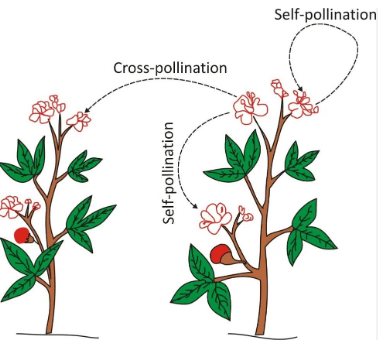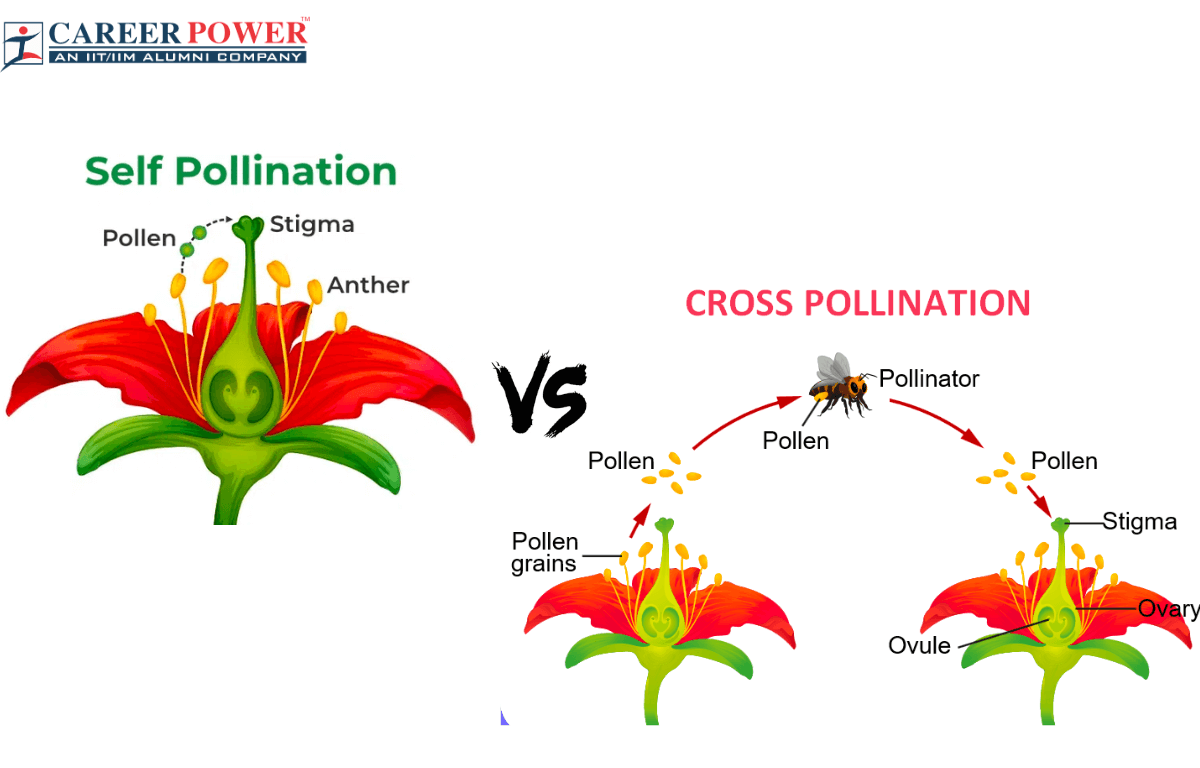As we all know that Pollination happens when pollen moves from the male part of a flower, called the anther, to the female part, called the stigma. This transfer can take place within the same flower or between different flowers. It is a crucial step for flowers to produce seeds and grow new plants. Pollination helps in the reproduction of plants by ensuring that pollen reaches the right part of the flower to make seeds. Here, in this article, we are discussing the “Difference Between Self Pollination and Cross Pollination”.
Types of Pollination
There are two types of Pollination in Biology i.e. Self Pollination and Cross Pollination.
Self Pollination: Self Pollination is the transfer of pollen grains from Anther to the Stigma of the same flower or two different flowers of the same plant.
Cross-Pollination: Cross-Pollination is the transfer of pollen grains from anther to the stigma of two flowers that are present in two different plants.

Differentiate between Self Pollination and Cross Pollination
There are many differences between self pollination and cross pollination according to the number of pollen grains produced, movement of pollens, evolution, and many more, some of them are discussed below:
| Self Pollination | Cross-Pollination |
| Self-pollination is the movement of Pollen Grains from Anther to Stigma either in a single flower or in two different flowers of the same plant. | Cross-pollination is the movement of pollen grains from Anther to Stigma of two different flowers of two different plants. |
| Self-pollination does not require any External Pollinating Agent for the transfer of pollen grains. | Cross-Pollination needs External Pollinating Agents such as wind, water, insects, and animals. |
| Self Pollination prevents the parental characteristics it occurs between genetically identical flowers. | Cross Pollination does not prevent any parental characteristics as it takes place between two genetically unidentical flowers. |
| The plants having Self Pollination may have small flowers. | Cross-pollination gives relatively larger flowers than self-pollination. The flowers are colorful and bright |
| Self Pollination helps in the production of Homozygous Offspring. | Cross-pollination produces heterozygous offspring. |
| It can take place even when the flower is closed. | It only occurs in open flowers. |
| Produces and transfers a limited number of Pollen Grains. | Produces and transfers a large number of pollen grains. |
| Self Pollination does not play any role in Evolution. | Cross-pollination plays a great role in evolution. |
| Self Pollination occurs only in 1/4th of the total number of flowering plants. | It occurs in almost 3/4th of the total number of flowering plants. |
| It limits a plant’s ability to adapt to changing environmental conditions. | It increases the plant’s ability to adapt to changing environmental conditions. |
| Examples of self-pollination are wheat, barley, oats, rice, tomatoes, peaches, and apricots. | Examples of cross-pollination are apples, Pears, Strawberries, etc. |
Advantages of Self-Pollination:
- If there is no compatible plant nearby then also self-pollination can take place.
- It leads to a high degree of genetic uniformity in the offspring.
- It is useful in preserving desirable traits such as disease resistance.
- Self-pollination allows a plant to reproduce at an early age than the plants that rely on cross-pollination.
Disadvantages of Self-Pollination:
- Self-pollination reduces or limits a plant’s ability to adapt to changes in the environment.
- It not only transfers useful traits but also the harmful ones .
- It lacks genetic diversity. It also does not play any role in the evolution.
- Poor-quality seeds are produced.
Advantages of Cross-Pollination
- It leads to the evolution of new plant varieties and increases the adaptability of the species.
- It allows the transfer of genetic material over a larger distance.
- The plants having cross-pollination produce nectar and colorful flowers.
- It gives good-quality seeds.
- It gives genetic variability by combining the genetic material of two different species.
Disadvantages of Cross-Pollination
- It can lead to unpredictable outcomes in terms of traits.
- In cross pollination plants lose their specific desirable traits.
- It leads to the production of hybrid species.
- It can decrease the preservation of traditional plant varieties.



 50 Vegetables Name for Kids in English a...
50 Vegetables Name for Kids in English a...
 Food Chain: Definition, Types, Examples,...
Food Chain: Definition, Types, Examples,...
 Human Respiratory System: Definition, Di...
Human Respiratory System: Definition, Di...













